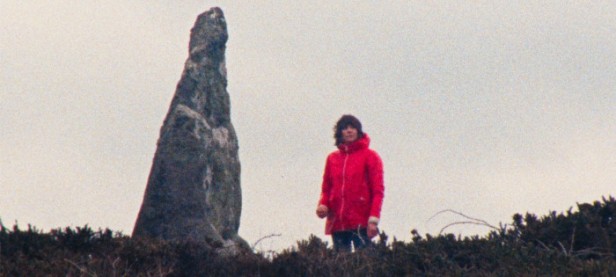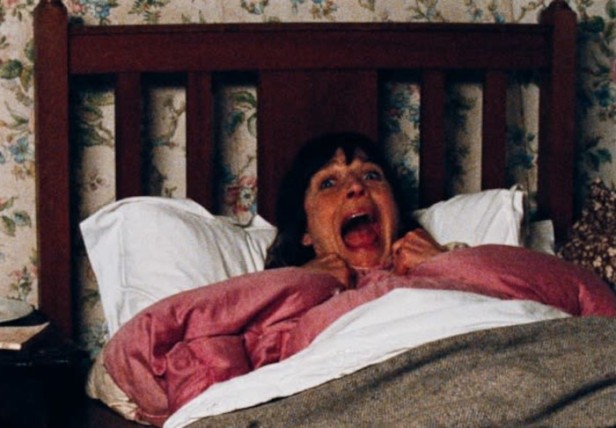Director Mark Jenkin had been surprised by some reactions to his 2019 feature Bait. “More and more people mentioned this sense of the uncanny,” he told Mark Salisbury of Screen Daily, “of foreboding and dread within Bait and the [short] I did before, Bronco’s House, that it was almost tipping into horror. So I thought, ‘I’m going to write a horror.'” Written in three nights and filmed in three weeks during the COVID-19 pandemic with a very small crew, the result is an often puzzling but always beguiling “folk horror.” Indeed Jenkin wanted to promote the film as “a lost Cornish folk horror” but was for some reason dissuaded, though it seems a perfectly good description of the film.
In April 1973, a woman (Mary Woodvine), never named and referred to in the credits only as “the volunteer”, lives alone on a remote island off the coast of Cornwall (the film’s title is Cornish for “Stone Island”). She spends her days monitoring the growth of a small patch of flowers and engaging in ritualised behaviour like strolling around her rocky, seemingly inhospitable home, dropping stones into a long-abandoned mine shaft and obsessively noting in her journal that there’s “no change” to the status of the flora she’s studying. As May Day approaches, time and reality seem to unravel around her. She retrieves a piece of driftwood that turns out to be part of the name plate of a fishing boat that hasn’t sunk yet; radio voices, ghostly sounds that occasionally cut through the static on her radio, mentions a monument erected half a century ago in “May 1973”; and the volunteer is visited by people who may be ghosts or alternative versions of herself – a young girl in 70s era clothing (Flo Crowe), fishermen who died in a maritime disaster, miners who died in a pit collapse, a troupe of “bal maidens,” female manual labourers associated with mining.

They’re not the only ghosts on show – those of The Wicker Man and Don’t Look Now, both released on a double bill in 1973, the year in which Enys Men is set, haunt the film as much as the apparitions that seem to stalk the volunteer. Then too there’s that much loved and oft-discussed strain of British television that has refused to fade away and which continues to haunt successive generations. Shot on grainy 16mm film, Enys Men does a remarkable job of recreating the texture and ambience of things like the A Ghost Story for Christmas strand, especially, perhaps, Stigma (1977) which, like Enys Men, prominently features an ominous standing stone. At a BFI season of films that influenced Jenkin, he quoted the British horror Symptoms (1974), Australian eco-horror Long Weekend (1978), and Cornish-set Children’s Film Foundation film Haunters of the Deep (1984) as fellow antecedents.
But though Jenkin is happy enough to show off his influences, Enys Men is still very much its own thing. On a technical level, it’s an extraordinary looking film. The colours of that 16mm film pop, red and yellow being particularly prevalent, starkly contrasting with the steely grey of the rocky island and the blue of the sea. It’s a beautifully shot (by Jenkin) film and it sounds remarkable too, thanks to a creepy ambient score written and performed by, yet again, the indefatigable Jenkin (as noted, it was made by the tiniest of crews). Music and sound play key roles in the film, particularly in underlining the erosion of the volunteer’s grip on reality. Those detached voices on the radio provide a chunk of the very little dialogue heard in the film, a seagull dives into the sea with the sound of shattering glass and the sudden uses of silence are often disquieting in the extreme.

The past emerges slowly from this beautifully created milieu, intruding insidiously on the volunteer’s life in often subtle ways. The first time we the mysterious younger woman – possibly her daughter, possibly a younger version of herself (they both develop a strange scar on their torso that becomes infected with the same lichen covering the flowers) – she’s barely noticeable, standing on the roof of an outbuilding next to the volunteer’s cottage. Other apparitions are more immediately noticeable, arriving in groups, arranged in silent tableaux, staring directly down the camera lens at the audience itself. The film is fill of disquietingly creepy images like this, Jenkin avoiding cheap jump scares in favour of a steady accumulation of dread and unease.
What it all means can remain frustratingly elusive. It would appear to be about the effects of loneliness and isolation but the exact meaning of details like the standing stone that seems to subtly change position throughout the film are never explained. Mary Woodvine does a superb job realising that loneliness on screen (her father John Woodvine turns up occasionally as a ghostly preacher) and carries an awful lot of the film herself, with only Crowe and Edward Rowe as the boatman (and her lover – or the object of her desire, again it’s never clear) providing the only other sizable roles, though she’s kept company after a fashion by those strange voices on the radio (“Are you there?” becomes a repeated refrain throughout the film until we realise late in the film that it’s actually the volunteer’s voice).

Jenkin isn’t all that keen on making the film easy for us and that’s no criticism – it’s pleasing to find a film that almost cajoles you into keeping up with it and forces you to pay attention and make up your own mind about what’s going on. Some have accused the film of being all style over substance and that may or may not be true – one suspects that there’s plenty of substance here but it’s substance that manifests itself differently to every viewer – but even if it is when the style is this evocative that seems like it’s OK really. It remains enigmatic to the very end, the volunteer seeming to become that ever-present, all-seeing stone, itself as covered in the lichen that she too was starting to succumb to.
One thing that you can take away from the film is the deep connection between the people of Cornwall and the land that they live on. The film was mostly shot on beautiful locations around Penwith where Jenkin lives (with additional scenes shot at The Lizard, at Mullion Cove): “It’s mostly moorland west of me, so we were able to shoot a lot of isolated, island-like shots out there,” he told Screen Daily and the sense of place her creates is quite remarkable. The whole history of Cornwall seems to be trapped in the ground of Enys Men, manifesting itself through its ghosts and visions. It’s a film that really couldn’t have been set anywhere else and of all of the crop of “folk horror” films that have flourished in recent years, it remains one of the most compelling, haunting and eerie of them all. One can only hope that Jenkin revisits the territory in future films.
For a film that can be made under such limited circumstances during a global pandemic, it’s most rewarding if it’s of a genre that can be refreshed for a new generation. And most particularly for horror films which, in regards to the truly best and especially scariest that a horror film still give audiences, may seem very rare for this century. Thank you, Kevin, for your review.
LikeLiked by 2 people